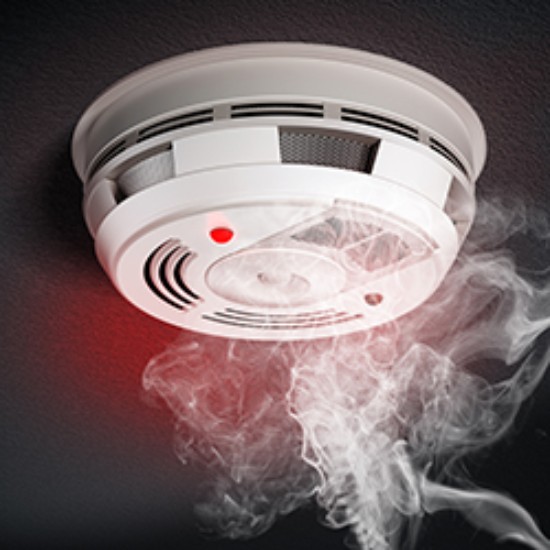
Because the terms “smoke detectors” and “smoke alarms” are used almost interchangeably it can be confusing to distinguish between the two devices. A smoke detector is part of the fire alarm system, it has a built-in sensor for smoke and sends a signal to the fire alarm panel. A smoke alarm is a stand-alone device with a sensor for smoke, a sounder, and a power supply. A smoke alarm is not connected to a fire alarm control panel, but may be interconnected with other smoke alarms within the building.
Legal requirements of Smoke Alarms in Rental Properties
Ohio
http://codes.ohio.gov/oac/4101%3A1-3
In Ohio, every apartment or rental property must have a smoke alarm installed in the immediate vicinity outside of all sleeping rooms, as well as inside each sleeping room. Alarm signaling devices must be clearly audible in all bedrooms within the unit when all internal doors are closed. Outside of the apartment units, property owners are required to have alarms installed in or near the return air stream for each floor. If the apartment does not have central return air systems, alarms need to be installed on each floor on the corridor or lobby side and within five feet of all stairway and elevator doors. If the apartment complex has fire walls and fire doors, smoke alarms must also be placed on each side of, and within fifteen feet of, the fire doors. Ohio also requires the smoke alarms to be interconnected within each unit and to have the primary power for smoke alarms to be from the building wiring with a battery backup.
Indiana
http://www.in.gov/dhs/files/Smoke_detector_statute-portion_for_website.pdf
In Indiana, an apartment or rental property must have at least one functional smoke alarm installed outside of each sleeping area in the immediate vicinity of the bedrooms. Smoke Alarms must be on each additional story of the dwelling, including basements, cellars, and habitable attics. Unless there is a door between levels in dwellings with split levels, a smoke alarm must be installed only on the upper level if the lower level is less than one full story below the upper level. All smoke alarms must be battery operated or hard wired into the dwelling’s electrical system, accessible for servicing and testing, maintained, and tested at least one time every six months by the unit occupant.
Kentucky
http://www.iompc.org/wp-content/uploads/2011/04/RESIDENTIAL-SMOKE-ALARMS.pdf
In Kentucky, smoke alarms are required to be installed in each sleeping room, outside each sleeping area in the immediate vicinity of bedrooms, and on each additional story of a dwelling, including basements. Smoke alarms are prohibited from being installed in locations where the temperatures fall below 32 degrees F or rise above 100 degrees F. It is not recommended to install smoke alarms in crawl spaces, uninhabitable attics, or closer than 3 feet from the door to a kitchen or bathroom with a tub or shower, with the exception of alarms specifically listed for the application.
Check your Local Laws
Wherever you are, it is important to review your local laws for requirements. For example, in Cincinnati it has been legally required since 2013 for all rental properties to have photoelectric smoke alarms installed outside the structure’s sleeping quarters. In addition, rental property owners are now required to inspect the photoelectric smoke alarms annually and when executing new lease agreements, and document their findings on the proper form which is checked by the Cincinnati Fire Inspectors and Community Development Building Officials.
Placement and Mounting of Smoke Alarms
NFPA 72 has guidelines for the placement of smoke alarms on walls or ceilings. A smoke alarm mounted on a ceiling is not to be closer than 4 inches from a wall. If mounted on a wall, the top of a smoke alarm must be between 4 to 12 inches from the ceiling. Mounting of a smoke alarm on a sloped, pitched, or cathedral ceiling, must be at or within 3 feet of the highest point of the peak.
Power Requirements and Interconnected Smoke Alarms
Smoke alarms are also required to be interconnected such that the activation of one alarm will cause all the alarms in the individual unit to sound. This is to ensure that every occupant in that unit can hear the alarm regardless of any closed doors between the individual and the sounding alarm.Smoke alarms are required to receive their primary power from the electrical service and a secondary power source of a battery. While it is the responsibility of the property owner or manager to install and maintain smoke alarms, it is generally the responsibility of the tenant or occupant to regularly test the smoke alarms and notify the landlord of any required maintenance. Owners are responsible for all smoke alarms in common areas, and should test smoke alarms inside apartments at a change of tenancy.
You can read more about smoke sensing technology here.
If you are a property manager, you may also be interested in reading about Carbon Monoxide Detection and Grill Safety & Laws for rental properties.
